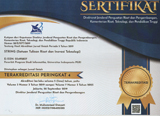Evaluasi Daya Dukung Lahan Permukiman di Kecamatan Sirimau Kota Ambon Menggunakan Teknik Penginderaan Jauh dan GIS
(1)
(*) Corresponding Author
Abstract
Developing settlements require adequate land to meet housing needs. However, significant challenges arise from rapid population growth and ongoing urbanization, making it difficult to maintain sufficient land-carrying capacity for the local population's sustainability and quality of life. This study analyses the land carrying capacity and settlement development in Sirimau District, Ambon City. The data collection methods include observations and documentation from secondary sources such as government reports and geospatial data. The analysis was conducted using time series satellite imagery from 2012 and 2022 and the nearest neighbour analysis method with ArcGIS and the Average Nearest Neighbor tool. The study's results indicate that the calculation of land carrying capacity shows an average decline in settlements' land carrying capacity. In 2022, Ahusen, Rijali, and Galala villages recorded a decrease in land carrying capacity, making them unable to accommodate the resident population. Population pressure and settlement growth have negatively impacted land carrying capacity. Significant settlement development occurred in Batu Merah and Soya villages, with a "clustered" settlement distribution pattern. The conclusions of this study emphasize the need to raise awareness and understanding of Regional Spatial Planning (RTRW) to achieve sustainable settlement development. An integrated effort from the government, community, and developers is required to optimize land use and maintain the ecological carrying capacity in Sirimau District.
Keywords
Full Text:
PDFReferences
E. F. Lambin and P. Meyfroidt, Global Land Use Change, Economic Globalization, and The Looming Land Scarcity, Proceedings of the National Academy of Sciences, vol. 108, no. 9, pp. 34653472, 2011, doi: 10.1073/pnas.1100480108.
X. Liao, C. Fang, and T. Shu, Multifaceted Land Use Change and Varied Responses of Ecological Carrying Capacity: A Case Study of Chongqing, China, Applied Geography, vol. 148, p. 102806, 2022, doi: https://doi.org/10.1016/j.apgeog.2022.102806.
S. Muhammad, X. Long, M. Salman, and L. Dauda, Effect of Urbanization and International Trade on CO2 Emissions Across 65 Belt and Road Initiative Countries, Energy, vol. 196, p. 117102, 2020, doi: https://doi.org/10.1016/j.energy.2020.117102.
F. Tan, L. Yang, Z. Lu, and Z. Niu, Impact of Urban Innovation on Urban Green Development in Chinas Yangtze River Economic Belt: Perspectives of Scale and Network, Environmental Science and Pollution Research, vol. 29, no. 49, pp. 7387873895, 2022, doi: 10.1007/s11356-022-21042-y.
D. Zhang and Y. Chen, Evaluation On Urban Environmental Sustainability and Coupling Coordination Among Its Dimensions: A case Study of Shandong Province, China, Sustainable Cities and Society, vol. 75, p. 103351, 2021, doi: https://doi.org/10.1016/j.scs.2021.103351.
E. Dinerstein et al., A Global Deal For Nature: Guiding Principles, Milestones, and Targets, Science Advances, vol. 5, no. 4, p. eaaw2869, 2019, doi: 10.1126/sciadv.aaw2869.
B. L. Turner, E. F. Lambin, and A. Reenberg, The emergence of Land Change Science for Global Environmental Change and Sustainability, Proceedings of the National Academy of Sciences of the United States of America, vol. 104, no. 52, pp. 2066620671, 2007, doi: 10.1073/pnas.0704119104.
X. P. Song et al., Global Land Change From 1982 to 2016, Nature, vol. 560, no. 7720, pp. 639643, 2018, doi: 10.1038/s41586-018-0411-9.
M. A. Lasaiba, Evaluation Of Settlement Land Suitability Based On Remote Sensing And Geographical Information Systems In The City Of Ambon, Spatial : Wahana Komunikasi dan Informasi Geografi., vol. 23, no. 1, pp. 7084, 2023, [Online]. Available: https://journal.unj.ac.id/unj/index.php/spatial/article/view/33157
P. Kusumadiya, O. Rusdiana, and S. Mulatsih, Analisis Daya Dukung untuk Mendukung Swasembada Pangan di Provinsi Kalimantan Utara, Journal of Environmental Engineering and Waste Management, vol. 8, no. 1, pp. 7990, 2023, doi: http://dx.doi.org/10.33021/jenv.v8i1.4109.
Z. Zhao et al., Fire Enhances Forest Degradation Within Forest Edge Zones in Africa, Nature Geoscience., vol. 14, no. 7, pp. 479483, 2021, doi: 10.1038/s41561-021-00763-8.
A. Mahfudin and U. F. Kurniawati, Arahan Pemanfaatan Lahan Melalui Pendekatan Telapak Ekologis di Kabupaten Lamongan, Jurnal Teknik ITS, vol. 12, no. 1, pp. 18, 2023, doi: 10.12962/j23373539.v12i1.99646.
E. Veldkamp, M. Schmidt, J. S. Powers, and M. D. Corre, Deforestation and reforestation impacts on soils in the tropics, Nature Reviews. Earth & Environment, vol. 1, no. 11, pp. 590605, 2020, doi: 10.1038/s43017-020-0091-5.
M. A. Lasaiba, Spatial-Temporal Variation of Land Use Changes In Ambon City, Rekayasa, vol. 16, no. 1, pp. 8495, 2023, doi: https://doi.org/10.21107/rekayasa.v16i1.18799.
A. M. Ambugadu and N. B. Hosni, Modelling Informal Settlements Expansion for Sustainable Urban Development: A Scientometric Review, PalArch's Journal of Archaeology of Egypt / Egyptology, vol. 19, no. 1, p. 1567, 2022, [Online]. Available: https://archives.palarch.nl/index.php/jae/article/view/10939
M. Ilmiah, Analisis Daya Dukung Fungsi Lindung Untuk Kelesterian Lingkungandi Subdas Logawa Kabupaten Banyumas, Geomedia, vol. 21, no. 1, pp. 4348, 2023, doi: 10.21831/gm.v21i1.43822 Abstract.
C. Ayu, N. Wahoni, E. Nurminda, D. Mandalika, and K. Kunci, Analisis Daya Dukung Lahan Pertanian Di Desa Penyangga Kawasan Ekonomi Khusus Mandalika - Kabupaten Lombok Tengah, JSEH (Jurnal Sosial Ekonomi dan Humaniora), vol. 9, no. 1, pp. 99106, 2023, doi: https://doi.org/10.29303/jseh.v9i1.314.
Z. Ouyang et al., Using Gross Ecosystem Product (GEP) to Value Nature in Decision Making, Proceedings of the National Academy of Sciences, vol. 117, no. 25, pp. 1459314601, 2020, doi: 10.1073/pnas.1911439117.
S. Sala, E. Crenna, M. Secchi, and E. Sany-Mengual, Environmental Sustainability of European Production and Consumption Assessed Against Planetary Boundaries, Journal of Environmental Management, vol. 269, no. April, 2020, doi: 10.1016/j.jenvman.2020.110686.
L. Qiu, Y. Pan, J. Zhu, G. S. Amable, and B. Xu, Integrated Analysis Of Urbanization-Triggered Land Use Change Trajectory and Implications for Ecological Land Management: A Case Study in Fuyang, China, Science of The Total Environment, vol. 660, pp. 209217, 2019, doi: 10.1016/j.scitotenv.2018.12.320.
F. Tan, F. Wang, and Z. Niu, Multiscale Disparity and Spatial Pattern of Comprehensive Carrying Capacity in The Yangtze River Economic Belt, China, Ecological Indicators, vol. 148, no. March, p. 110119, 2023, doi: 10.1016/j.ecolind.2023.110119.
W. S. J. Aswad and H. M. Kesaulya, Analisis Kapasitas Daya Dukung dan Daya Tampung Lingkungan Hidup Kawasan Perkotaan Demak dengan Pendekatan Supply dan Demand, Innovative: Journal Of Social Science Research, vol. 3, no. 2, pp. 77727789, 2023, doi: https://doi.org/10.31004/innovative.v3i2.1265.
M. A. Islam, T. A. Rickty, P. K. Das, and M. B. Haque, Modeling and Forecasting Urban Sprawl in Sylhet Sadar Using Remote Sensing Data, Proceedings of Engineering and Technology Innovation, vol. 23, pp. 2335, 2023, doi: 10.46604/peti.2023.9617.
X. Cao, Y. Shi, and L. Zhou, Research on Urban Carrying Capacity Based on Multisource Data FusionA Case Study of Shanghai, Remote Sensing, vol. 13, no. 14, p. 2695, 2021, doi: 10.3390/rs13142695.
N. T. T. Nguyen and H. T. Tong, Predicting Land Use Change Base on GIS and Remote Sensing, Journal of Mining and Earth Sciences, vol. 61, no. 2, pp. 106115, 2020, doi: 10.46326/jmes.2020.61(2).12.
K. Dhanaraj and D. P. Angadi, Land Use Land Cover Mapping and Monitoring Urban Growth Using Remote Sensing and GIS Techniques in Mangaluru, India, GeoJournal, vol. 87, no. 2, pp. 11331159, 2020, doi: 10.1007/s10708-020-10302-4.
H. Wang, Y. Cao, X. Wu, A. Zhao, and Y. Xie, Estimation and Potential Analysis of Land Population Carrying Capacity in Shanghai Metropolis, International Journal of Environmental Research and Public Health, vol. 19, no. 14, p. 8240, Jul. 2022, doi: 10.3390/ijerph19148240.
F. Djalil, F. Lihawa, and S. Koem, Kajian Daya Dukung Lahan Permukiman Kota Gorontalo, GEOGRAPHY : Jurnal Kajian, Penelitian dan Pengembangan Pendidikan vol. 11, no. 2, p. 322, 2023, doi: 10.31764/geography.v11i2.16271.
S. Gustafsson, B. Hermelin, and L. Smas, Integrating Environmental Sustainability into Strategic Spatial Planning: The Importance Of Management, Journal of Environmental Planning and Management, vol. 62, no. 8, pp. 13211338, 2018, doi: 10.1080/09640568.2018.1495620.
DOI: http://dx.doi.org/10.30998/string.v9i1.18409
Refbacks
- There are currently no refbacks.
Copyright (c) 2024 Mohammad Amin JLasaiba

This work is licensed under a Creative Commons Attribution 4.0 International License.
STRING (Satuan Tulisan Riset dan Inovasi Teknologi) indexed by:

Ciptaan disebarluaskan di bawah Lisensi Creative Commons Atribusi 4.0 Internasional.
View My Stats


 Sertifikat Akreditasi
Sertifikat Akreditasi
















